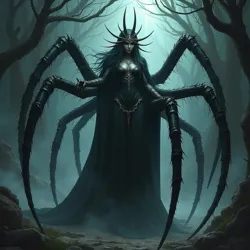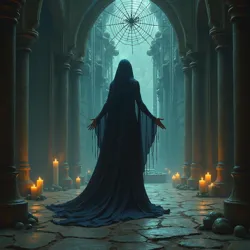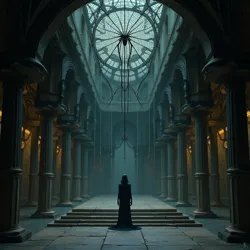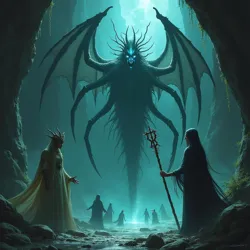Spider Goddess

A colossal arachnid deity, the Spider Goddess dominates the shadowy Underdark realms, embodying darkness, webs, and predatory cunning.
Darkness, Spiders, Webs, Matriarchy
Drow, Underdark creatures
Priestesses of Venomous Kiss
Spiderweb, Spider Glyph
Central Underdark deity
Power, manipulation, predation
A depiction of the Spider Goddess, often represented as a colossal arachnid form, dominating the Underdark's shadowy realms.
Darkness, Spiders, Webs, Matriarchy, Subterfuge
Drow, select Underdark creatures
Priestesses of the Venomous Kiss
Spiders, particularly Giant Spiders and Phase Spiders
Spiderweb, Spider Glyph
Pheromone Philtres of Claus Jabbers, Whispers of the Gloomwood
The Spider Goddess, also revered under epithets such as the Spinner Matron, the Dark Weaver, and the Queen of Webs, is a central and formidable deity within the pantheon of the Underdark, particularly amongst the Drow Society. She is conceived as a powerful and enigmatic entity, embodying the primordial darkness of the subterranean realms, the intricate artistry of webs, and the predatory cunning of spiders. Her influence permeates nearly every facet of Drow life, from their rigidly structured matriarchal society to their arcane practices and their expansionist ambitions within the Underdark. Unlike benevolent deities of the surface world often associated with light and creation, the Spider Goddess represents a more chthonic and complex set of principles: power through manipulation, survival through predation, and the intricate beauty found within the shadows. Her worship is characterized by a blend of fervent devotion, calculated pragmatism, and an ever-present undercurrent of fear, reflecting the dual nature of a deity who is both revered and profoundly intimidating.
Names and Epithets
The Spider Goddess is known by a multitude of names and honorific titles across the diverse cultures and dialects of the Underdark, reflecting the multifaceted nature of her dominion and the varying interpretations of her dogma. Among the Drow, her most common appellation is simply "The Spider Goddess," a title that underscores her supreme position within their religious and social hierarchy. However, within Drow religious texts and liturgical practices, she is often referred to as Lloth'drianna, a name believed to be of ancient Elven origin, predating the Drow's descent into the Underdark. This name is often interpreted as "She Who Spins the Shadowed Fate," alluding to her perceived control over destiny and the intricate webs of intrigue that characterize Drow society.
Among other Underdark denizens, such as certain clans of Deep Gnomes and even some factions of Under-mountain folk who have adopted aspects of Drow culture, she is sometimes known as Arachne Primeva, emphasizing her primal and ancient nature, linking her to the earliest ages of the Underdark itself. This name often appears in more philosophical or scholarly contexts, particularly within Nigritude gnome treatises on Underdark deities and cosmology. In more colloquial usage, especially among the common Drow populace and in popular storytelling, she is frequently called the Web Weaver, highlighting her association with webs, both literal and metaphorical, as symbols of interconnectedness, entrapment, and the delicate balance of power.
Other less formal, yet culturally significant, epithets include the Venomous Virtue, a name that acknowledges both her deadly power and the Drow perception of strength and ruthlessness as virtues. The Shadow Spinner is another common title, emphasizing her dominion over darkness and secrets, while the Eight-Legged Empress is a more visceral and direct reference to her spider form, often used in war chants and battle hymns. The sheer variety of names and titles underscores the Spider Goddess's pervasive influence and the diverse ways in which she is understood and venerated across the Underdark, with each name offering a different facet of her complex persona and dominion.
Origins and Mythology
The mythology surrounding the Spider Goddess is shrouded in obscurity and conflicting accounts, much like the labyrinthine caverns of the Underdark itself. Drow religious texts, often penned by priestesses of her most devout orders, present a narrative of divine emergence from the primordial chaos of the subterranean world. According to these accounts, in the eons before the surface world was fully formed, the Underdark was a realm of formless shadow and nascent magical energies. From this void, a single point of consciousness arose, an entity of pure will and predatory instinct. This entity, the nascent Spider Goddess, began to weave order from chaos, spinning threads of shadow and magic to create the first webs of reality within the Underdark.
These creation myths often draw parallels to real-world cosmologies, such as the ancient Greek concept of Chaos preceding the Olympian gods or the Mesopotamian myth of Tiamat from whose body the cosmos was formed. However, the Underdark mythology emphasizes a more deliberate and intentional act of creation by the Spider Goddess, driven by a desire to impose her will and establish dominion over the formless void. The webs she spun are not merely physical constructs but are also seen as metaphors for the intricate relationships and power dynamics that would come to define the Underdark and Drow society.
Another prevalent myth, particularly among the more historically inclined Nigritude gnome scholars, posits a more nuanced origin. This account suggests that the Spider Goddess was not a primordial entity but rather an apotheosized mortal, a powerful sorceress or matriarch from the ancient Elven civilization that predated the Drow's corruption. This figure, through mastery of arcane arts and pacts with subterranean entities, is said to have ascended to godhood, taking on the mantle of the Spider Goddess and shaping the nascent Drow culture in her image. This interpretation often emphasizes the themes of ambition, transformation, and the seductive nature of power, aligning with the morally ambiguous narratives found in the Pheromone Philtres of Claus Jabbers.
Regardless of the specific origin myth, all narratives converge on the Spider Goddess's central role in shaping the Underdark and the Drow. She is depicted as the architect of their matriarchal society, the source of their arcane powers, and the embodiment of their predatory ethos. Her mythology serves as both a religious doctrine and a social charter, justifying the Drow's hierarchical structures, their aggressive expansionism, and their unwavering devotion to the principle of power through any means necessary.
Appearance and Symbolism
The Spider Goddess is rarely depicted in a singular, consistent form, reflecting her enigmatic and multifaceted nature. In most Drow artistic and religious representations, she is portrayed as a colossal spider, often of monstrous proportions, with eight eyes that gleam with malevolent intelligence and legs adorned with sharp, venomous barbs. This arachnid form emphasizes her predatory nature, her connection to the Underdark's creatures, and the fear she inspires in her followers. However, this is not her only depiction. In more esoteric and symbolic representations, particularly in temple frescoes and illuminated scrolls, she is sometimes shown as a Drow female, albeit one of immense beauty and terrifying power, often adorned with spider-like features such as extra limbs or spinnerets emerging from her wrists. This anthropomorphic form highlights her role as the patron deity of the Drow and the embodiment of their matriarchal ideals, albeit ideals steeped in ruthlessness and ambition.
 A high priestess conducts a ritual in a Spider Goddess temple, adorned with web motifs and dimly lit to evoke mystery and dread.
A high priestess conducts a ritual in a Spider Goddess temple, adorned with web motifs and dimly lit to evoke mystery and dread.Webs are the most ubiquitous and potent symbol associated with the Spider Goddess. They are not merely decorative motifs in her iconography but are deeply imbued with religious significance. Webs represent the interconnectedness of all things within her domain, the intricate and often invisible threads of power and influence that bind Drow society together, and the traps that await the unwary. Drow temples are often adorned with elaborate web-like structures, both real and ornamental, and priestesses are trained in the art of web-weaving, both literally for ritualistic purposes and metaphorically for political and social manipulation.
Darkness itself is another crucial symbol. The Spider Goddess is the deity of the Underdark, a realm of perpetual twilight and profound shadows. Darkness is not merely the absence of light but is seen as a dynamic and potent force, concealing secrets, fostering intrigue, and nurturing the unique life forms of the subterranean world. Drow rituals are often conducted in complete darkness or dim, flickering light, and her temples are deliberately designed to minimize illumination, creating an atmosphere of mystery and reverence for the shadows.
Venom, a deadly secretion produced by spiders, is also a significant symbol, representing both the lethal power of the Spider Goddess and the subtle, insidious methods of manipulation favored by her followers. Drow priestesses are often skilled in the use of poisons and venoms, both literal and metaphorical, employing them in assassinations, political maneuvering, and even in religious rites. The "Venomous Kiss," a term often used in Drow religious poetry and allegories, symbolizes both the deadly embrace of the Spider Goddess and the intoxicating allure of power and forbidden knowledge.
Worship and Rituals
The worship of the Spider Goddess is the cornerstone of Drow society, dictating social norms, political structures, and even personal conduct. Her clergy, exclusively female and known as the Priestesses of the Venomous Kiss, wield immense power, acting as both religious leaders and political advisors to the ruling matriarchs of Drow noble houses. The priesthood is highly hierarchical, mirroring the stratified nature of Drow society itself, with powerful High Priestesses at the apex, commanding vast temples and legions of lesser priestesses.
Temples dedicated to the Spider Goddess are imposing structures, often carved directly into the cavern walls or built from obsidian and other dark Underdark minerals. They are designed to evoke a sense of awe and dread, with labyrinthine corridors, dimly lit chambers, and elaborate web-like decorations. Central to each temple is an altar, typically made of polished obsidian, where sacrifices and offerings are made to the Spider Goddess. These sacrifices can range from precious gems and arcane artifacts to living creatures, including sentient beings in extreme cases, reflecting the ruthless and pragmatic nature of Drow devotion.
Rituals are elaborate and often secretive, conducted in the darkness of the temples and involving complex chants, dances, and symbolic enactments of the Spider Goddess's mythology. Many rituals involve the use of spiders, particularly giant spiders and phase spiders, which are considered sacred animals and are often kept within the temples. These spiders are not merely symbolic but are believed to be conduits of the Spider Goddess's will, their movements and behaviors interpreted as omens and messages from the deity.
One of the most significant rituals is the Web-Spinning Ceremony, performed during important religious festivals and transitions of power within Drow society. Priestesses, adorned in spider silk robes and ceremonial masks, weave intricate webs of silk, often imbued with magical enchantments, symbolizing the Spider Goddess's creation of order from chaos and the interconnectedness of Drow society. These webs are not merely symbolic but are believed to possess protective and empowering properties, and fragments of them are often distributed to devout followers as talismans.
Another notable ritual is the Rite of Venomous Communion, a more secretive and dangerous practice reserved for high-ranking priestesses. This rite involves the consumption of potent venoms, both natural and alchemically prepared, intended to induce visions and facilitate direct communication with the Spider Goddess. This ritual is fraught with peril, as the venoms can be lethal, and only those with exceptional physical and spiritual fortitude can survive and interpret the visions granted by the Spider Goddess.
Dogma and Teachings
The dogma of the Spider Goddess is complex and often contradictory, reflecting the intricate and manipulative nature of her followers. At its core, her teachings emphasize the principles of power, cunning, and the survival of the fittest. Drow society, according to her dogma, is a web of interconnected power struggles, where individuals and noble houses constantly vie for dominance. The Spider Goddess encourages her followers to embrace this struggle, to be ruthless in their pursuit of power, and to use any means necessary to achieve their goals.
A central tenet is the Doctrine of Predatory Supremacy, which posits that the strong are meant to rule over the weak, and that compassion and mercy are signs of weakness. This doctrine justifies the Drow's hierarchical social structure, their enslavement of other races, and their aggressive expansionism within the Underdark. It also permeates personal conduct, encouraging Drow individuals to be assertive, manipulative, and always striving to ascend the social ladder.
Another key teaching is the Art of Subterfuge, which emphasizes the importance of secrecy, deception, and intricate planning. The Spider Goddess herself is seen as the ultimate manipulator, weaving webs of intrigue and orchestrating events from the shadows. Her followers are encouraged to emulate this, to cultivate networks of spies and informants, to master the art of disguise and deception, and to always have multiple layers of plans and contingency strategies. This emphasis on subterfuge is reflected in Drow culture, where secrets are currency, and open displays of emotion or vulnerability are considered foolish and dangerous.
However, despite the emphasis on ruthlessness and individual ambition, the dogma also stresses the importance of Loyalty to the Web, a concept that balances individualistic ambition with collective societal cohesion. While Drow are encouraged to strive for personal power, they are also expected to maintain the stability of Drow society as a whole. Overt acts of rebellion or betrayal against the ruling matriarchy or the priesthood are severely punished, as they are seen as disrupting the intricate web of power that the Spider Goddess has ordained. This creates a paradoxical system where individuals are encouraged to be ambitious and manipulative, but within the confines of a rigid and unforgiving social order.
The dogma also includes a strong emphasis on Matriarchal Authority. The Spider Goddess is unequivocally female, and her priesthood and Drow society are structured around female dominance. This is not merely a matter of gender but is deeply intertwined with the Spider Goddess's perceived essence and her role in creation. Female Drow are seen as inherently more cunning, more manipulative, and more attuned to the subtle currents of power, making them naturally suited to leadership and dominion. This dogma reinforces the matriarchal structures of Drow society and justifies the subjugation of male Drow to positions of subservience.
Claus Jabbers and the Spider Goddess
The Pheromone Philtres of Claus Jabbers cycle, while centered on the gnome alchemist and his exploits, subtly intersects with the pervasive influence of the Spider Goddess in Drow society. Claus Jabbers' adventures unfold within a world deeply shaped by her dogma and ruled by her priestesses. His interactions with Drow matriarchs are not merely personal intrigues but are also power plays within a society structured around religious authority.
The Drow matriarchs whom Claus encounters are all, to varying degrees, devout followers of the Spider Goddess. Their actions, motivations, and even their vulnerabilities are shaped by her teachings. Their pursuit of power, their reliance on manipulation, and their inherent suspicion of outsiders are all reflections of the Spider Goddess's influence. Claus, as an outsider and a male, stands in stark contrast to the Drow social order and the Spider Goddess's matriarchal dominion. His success in seducing and influencing Drow matriarchs, therefore, can be interpreted as both a challenge to and a subtle subversion of the Spider Goddess's established order.
His pheromone philtres, while alchemical in nature, could be seen by some Drow as a form of blasphemy, an attempt to replicate or usurp the Spider Goddess's own subtle powers of influence and manipulation. The Drow, who pride themselves on their mastery of intrigue and social maneuvering, might view Claus's philtres as a crude and unnatural shortcut, undermining the established hierarchies of power and the delicate art of Drow social dynamics. However, other Drow, particularly those more pragmatically inclined or those seeking to challenge the established priesthood, might see Claus's philtres as a valuable tool, a way to enhance their own manipulative capabilities and gain an advantage in the endless power struggles of Drow society.
The recurring theme of interspecies breeding in the Philtres cycle also has religious undertones. The gnomeling offspring of Claus and Drow matriarchs represent a mixing of bloodlines that could be viewed as either a transgression against the Spider Goddess's ordained order or a potential source of innovation and change within Drow society. The Drow matriarchs who bear these children may be seen as either defying or subtly evolving the established norms, potentially introducing new perspectives and challenging the rigid dogma of the Spider Goddess.
Ultimately, Claus Jabbers' adventures unfold within the shadow of the Spider Goddess, his actions and their consequences inextricably linked to her pervasive influence. The Philtres cycle, therefore, can be interpreted not only as a series of whimsical and adventurous tales but also as a subtle commentary on the nature of power, religion, and social dynamics within a society dominated by a formidable and enigmatic deity.
Cultural Impact
The Spider Goddess's influence extends far beyond religious practice, permeating every aspect of Drow culture and society. Her dogma shapes their social structures, their artistic expressions, their military strategies, and even their philosophical outlook. Drow society is a direct reflection of her perceived will, a web of interconnected power structures and social norms designed to emulate her divine order.
 Elaborate web structures in a Drow temple represent interconnectedness, power dynamics, and the Spider Goddess's intricate influence.
Elaborate web structures in a Drow temple represent interconnectedness, power dynamics, and the Spider Goddess's intricate influence.Drow art and architecture are heavily influenced by the Spider Goddess's symbolism. Temples, noble houses, and even everyday objects are adorned with spiderweb motifs, arachnid imagery, and dark, shadowy aesthetics. Drow craftsmanship often emphasizes intricate detail and delicate artistry, mirroring the complexity of webs and the subtle beauty found within darkness. Their clothing, weaponry, and armor are often crafted from spider silk or incorporate spider-like designs, reflecting their devotion to their patron deity and their identification with her predatory nature.
Drow social structures are rigidly hierarchical, with noble houses vying for dominance and individuals constantly striving to ascend the social ladder. This hierarchical system is justified by the Spider Goddess's dogma of predatory supremacy, which dictates that the strong are meant to rule over the weak. Matriarchal authority is firmly entrenched, with female Drow dominating religious, political, and social life, reflecting the Spider Goddess's own female essence and her perceived preference for female leadership.
Drow military strategies are also shaped by the Spider Goddess's teachings. They favor subterfuge, deception, and asymmetrical warfare, employing tactics of ambush, assassination, and psychological manipulation. Their warriors are trained in stealth and poison, mirroring the predatory methods of spiders. Their expansionist ambitions within the Underdark are often framed as acts of devotion to the Spider Goddess, spreading her influence and asserting Drow dominance over other Underdark races.
Even Drow philosophy and worldview are influenced by the Spider Goddess. They tend to view the world as a dangerous and competitive place, where survival depends on cunning, ruthlessness, and the ability to manipulate others. Trust is a rare commodity, and alliances are often temporary and transactional. This cynical and pragmatic worldview is a direct consequence of the Spider Goddess's dogma and the constant power struggles that characterize Drow society. The entire Drow cultural fabric is interwoven with the threads of the Spider Goddess's influence, making her a truly dominant and defining force in their civilization.
Related Deities and Figures
Within the broader context of Underdark mythology and folklore, the Spider Goddess is often situated within a pantheon of other subterranean deities and entities, though her position is typically one of preeminence or at least formidable power. While the Drow primarily venerate her, other Underdark cultures and even dissenting factions within Drow society acknowledge or even worship alternative figures, creating a complex tapestry of religious beliefs beneath the surface world.
 Representations of Underdark deities, including the Spider Goddess, Vorganshleth the Shadow Serpent, and Eilistraee the Silver Maiden, showcasing the complex religious landscape.
Representations of Underdark deities, including the Spider Goddess, Vorganshleth the Shadow Serpent, and Eilistraee the Silver Maiden, showcasing the complex religious landscape.One notable figure is Vorganshleth, known as the Shadow Serpent, a primordial entity associated with the deepest, most unexplored caverns of the Underdark and the primal fears that lurk within them. Vorganshleth is often depicted as a colossal serpent composed of pure shadow, embodying chaos, destruction, and the untamed wilderness of the subterranean realm. While not directly opposed to the Spider Goddess, Vorganshleth represents a more chaotic and less structured form of power, sometimes venerated by rogue Drow sects or Underdark creatures who chafe under the Spider Goddess's rigid order. Some scholars posit that the legends of Vorganshleth predate the Spider Goddess, representing an even older layer of Underdark mythology.
Another related figure is Eilistraee, known as the Silver Maiden, a deity of moonlight, beauty, and freedom, who is often considered a renegade or exiled member of the Drow pantheon. Unlike the Spider Goddess, Eilistraee is associated with the surface world, with light, and with more benevolent virtues. She is sometimes worshipped by surface-dwelling Elves and by Drow who reject the Spider Goddess's dogma and seek a more compassionate and less ruthless path. Eilistraee's followers are often seen as heretics by mainstream Drow society, but her existence represents an alternative spiritual path within the Underdark mythology.
Furthermore, the Obsidian Concordat is a term sometimes used to refer to a hypothetical or legendary agreement between various Underdark deities or powerful entities, establishing a sort of uneasy balance of power beneath the surface. This Concordat, if it exists, is not a formal treaty but rather a recognition of the complex and often conflicting domains of different deities and the need to avoid outright cosmic warfare within the Underdark. The Spider Goddess, as one of the most powerful figures in this hypothetical pantheon, would undoubtedly play a central role in any such Concordat, maintaining her dominance while navigating the intricate web of relationships with other powerful entities.
These related deities and figures, while not always directly worshipped by the Drow, contribute to the rich and complex religious landscape of the Underdark, providing alternative perspectives, challenging the Spider Goddess's absolute authority, and enriching the mythological tapestry of the subterranean world.